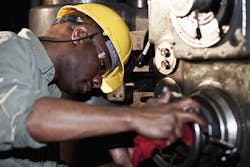New predictive maintenance (PdM) technologies are designed and improved all the time. Condition-based monitoring (CBM) components are built directly into new equipment or retrofitted into existing machines and systems. With increasingly advanced automation, a tendency develops in some circles to wonder if nuts and bolts, knuckle-busting, grease-under-the-fingernails preventive maintenance will soon go the way of the horse and buggy. Will preventive maintenance always be necessary? While PdM and CBM are increasingly sophisticated and prevalent, qualified maintenance craftsmen will always be needed. Their roles may evolve and new skills are required to stay up to date and interact with new technology. However, for the foreseeable future, some form of human interaction must remain.
Machines are not without their flaws. Although PdM greatly reduces unexpected failures, extends equipment life cycles and generally creates a maintenance environment that was but a dream only a few generations ago, it is neither a panacea for all issues nor a stand-alone solution. Once data is acquired from the PdM program or the CBM alarm, a qualified person needs to analyze and interpret the information, interact with the machine, make the required corrections and use deductive reasoning to prevent failures or deterioration. When it comes to maintenance, the human element cannot be completely eliminated.
Back to the basics
The backbone of any maintenance program revolves around three basic principles: cleaning, lubrication and inspection. These activities may be calendar-driven, prompted by data gleaned from PdM and CBM or hour-based depending on the equipment. No matter how state-of-the-art a site’s computerize maintenance management system may be, a great deal of work will fall under one of the three preventive maintenance umbrellas. Operations staff will be responsible for performing these tasks proficiently with occasional training and assistance from the maintenance department. Each of these three groupings requires someone to get the job done.
Figure 1. The five-rung best practices ladder can help operators prioritize maintenance needs. Graphic courtesy of T.A. Cook.
1. Cleaning — When was the last time a car cleaned itself or the laundry was automatically washed, dried and folded? Although it would be nice if dirty dishes could walk themselves into the dishwasher, this does not happen. Although innovators dream of a day when this kind of automation becomes a reality, technology has not eliminated the need for good, old-fashioned elbow grease. The same holds true for production equipment, whether in the food and bottling, manufacturing, or oil and gas industries. Even with a clean-in-place system, a person has to determine the need for cleaning, schedule the time frame, and either program the system or at the very least push a button. Whether it is a heat exchanger or a soft drink palletizer, all equipment gets dirty. Eventually equipment will require intervention and some effort to return it to proper operating parameters and cleanliness. Some environments are more severe than others, in which case an employee must determine how frequent this maintenance task should take place. The basic, simple act of cleaning is extremely important to prevent further deterioration and/or loss of performance.
2. Lubrication — Automobiles are now sophisticated enough to notify the owner when it is time to change the oil, perform basic upkeep, and even inflate or rotate the tires. However, car maintenance also includes taking the vehicle to a mechanic’s shop, where a human being performs mundane but essential preventive tasks to increase the machine’s life and usefulness. Practically all equipment designed to move or rotate will require some type of lubrication. On many sites, this task is still performed by an employee with a grease gun making rounds. In more high-tech units, equipment may be automatically lubricated via a canister or fixed lines attached to a bearing, or a grease system that may continually lubricate the entire unit. Even then, someone must be responsible for checking the system to see if the lubrication needs replenishing. A monitor with a level on display may be used, or a lubricant vendor can visit the site each week to check in on the system. In short, all gauges and dials need a person assigned to monitoring tasks.
3. Inspection — The operator should perform a general look, listen, kick-the-tires inspection before commencing operation, or if the equipment is already operational, at the beginning of each shift. The operator is, or should be, intimately familiar with the equipment and its particular sounds, behaviors and parameters under varying conditions and circumstances. By taking advantage of daily walk-arounds, whether it is on one piece of equipment or a whole unit, the operator will be the first to note if something is amiss or not functioning properly and notify maintenance. Of the five-rung best practices ladder (see Figure 1), preventive and operator-involved maintenance are Nos. 2 and 3, respectively. Low-tech, cleaning, lubrication and inspection are all essential to a site’s upkeep. Regardless of how advanced plant systems become, these tasks cannot be overlooked or reduced. Even in the age of smart houses and the Industrial Internet of Things, when it comes to following a dynamic, effective maintenance program, humans on the ground will never go out of style.
Mike Johnston, CMRP, is a senior consultant at T.A. Cook Consultants Inc. Following a number of engineering roles at HBS Reliability Technologies/ABB as senior continuous improvement analyst, he joined T.A. Cook in 2009. Johnston provides strategic turnaround, maintenance work process and uptime improvement advice to businesses in the oil and gas, petrochemical and chemical industries in North America.





